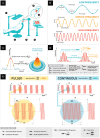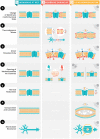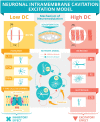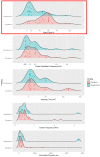Current State of Potential Mechanisms Supporting Low Intensity Focused Ultrasound for Neuromodulation
- PMID: 35547195
- PMCID: PMC9081930
- DOI: 10.3389/fnhum.2022.872639
Current State of Potential Mechanisms Supporting Low Intensity Focused Ultrasound for Neuromodulation
Abstract
Low intensity focused ultrasound (LIFU) has been gaining traction as a non-invasive neuromodulation technology due to its superior spatial specificity relative to transcranial electrical/magnetic stimulation. Despite a growing literature of LIFU-induced behavioral modifications, the mechanisms of action supporting LIFU's parameter-dependent excitatory and suppressive effects are not fully understood. This review provides a comprehensive introduction to the underlying mechanics of both acoustic energy and neuronal membranes, defining the primary variables for a subsequent review of the field's proposed mechanisms supporting LIFU's neuromodulatory effects. An exhaustive review of the empirical literature was also conducted and studies were grouped based on the sonication parameters used and behavioral effects observed, with the goal of linking empirical findings to the proposed theoretical mechanisms and evaluating which model best fits the existing data. A neuronal intramembrane cavitation excitation model, which accounts for differential effects as a function of cell-type, emerged as a possible explanation for the range of excitatory effects found in the literature. The suppressive and other findings need additional theoretical mechanisms and these theoretical mechanisms need to have established relationships to sonication parameters.
Keywords: focused ultrasound stimulation; low intensity focused ultrasound; neuromodulation; non-invasive brain stimulation; transcranial focused ultrasound.
Copyright © 2022 Dell'Italia, Sanguinetti, Monti, Bystritsky and Reggente.
Conflict of interest statement
AB is founder and major stockholder of Brainsonix Corp. and is a patent holder in the field of FUS brainstimulation. The remaining authors declare that the research was conducted in the absence of any commercial or financial relationships that could be construed as a potential conflict of interest.
Figures




Similar articles
-
The therapeutic potential of low-intensity focused ultrasound for treating substance use disorder.Front Psychiatry. 2024 Nov 19;15:1466506. doi: 10.3389/fpsyt.2024.1466506. eCollection 2024. Front Psychiatry. 2024. PMID: 39628494 Free PMC article. Review.
-
Low Intensity Focused Ultrasound for Non-invasive and Reversible Deep Brain Neuromodulation-A Paradigm Shift in Psychiatric Research.Front Psychiatry. 2022 Feb 24;13:825802. doi: 10.3389/fpsyt.2022.825802. eCollection 2022. Front Psychiatry. 2022. PMID: 35280168 Free PMC article. Review.
-
A review of low-intensity focused ultrasound for neuromodulation.Biomed Eng Lett. 2017 Jan 9;7(2):135-142. doi: 10.1007/s13534-016-0007-y. eCollection 2017 May. Biomed Eng Lett. 2017. PMID: 30603160 Free PMC article. Review.
-
Low-intensity ultrasound neuromodulation: An overview of mechanisms and emerging human applications.Brain Stimul. 2018 Nov-Dec;11(6):1209-1217. doi: 10.1016/j.brs.2018.08.013. Epub 2018 Aug 23. Brain Stimul. 2018. PMID: 30166265 Review.
-
A Wearable, Steerable, Transcranial Low-Intensity Focused Ultrasound System.J Ultrasound Med. 2025 Feb;44(2):239-261. doi: 10.1002/jum.16600. Epub 2024 Oct 24. J Ultrasound Med. 2025. PMID: 39449176 Free PMC article.
Cited by
-
Low-intensity pulsed ultrasound stimulation (LIPUS) modulates microglial activation following intracortical microelectrode implantation.Nat Commun. 2024 Jun 29;15(1):5512. doi: 10.1038/s41467-024-49709-9. Nat Commun. 2024. PMID: 38951525 Free PMC article.
-
Modeling ultrasound modulation of neural function in a single cell.Heliyon. 2023 Nov 21;9(12):e22522. doi: 10.1016/j.heliyon.2023.e22522. eCollection 2023 Dec. Heliyon. 2023. PMID: 38046165 Free PMC article.
-
Alterations in large-scale resting-state network nodes following transcranial focused ultrasound of deep brain structures.Front Hum Neurosci. 2024 Dec 4;18:1486770. doi: 10.3389/fnhum.2024.1486770. eCollection 2024. Front Hum Neurosci. 2024. PMID: 39698148 Free PMC article.
-
A Bioelectric Router for Adaptive Isochronous Neurostimulation.bioRxiv [Preprint]. 2025 Feb 1:2025.01.28.635122. doi: 10.1101/2025.01.28.635122. bioRxiv. 2025. Update in: Sci Rep. 2025 Jul 4;15(1):23958. doi: 10.1038/s41598-025-07568-4. PMID: 39975050 Free PMC article. Updated. Preprint.
-
State-dependent neurovascular modulation induced by transcranial ultrasound stimulation.Med Biol Eng Comput. 2025 Jun;63(6):1797-1808. doi: 10.1007/s11517-025-03290-5. Epub 2025 Jan 28. Med Biol Eng Comput. 2025. PMID: 39870987
References
-
- Ai L., Mueller J. K., Grant A., Eryaman Y., Legon W. (2016). Transcranial focused ultrasound for BOLD fMRI signal modulation in humans, in 2016 38th Annual International Conference of the IEEE Engineering in Medicine and Biology Society (Orlando, FL: IEEE; ), 1758–1761. 10.1109/EMBC.2016.7591057 - DOI - PubMed
Publication types
LinkOut - more resources
Full Text Sources

